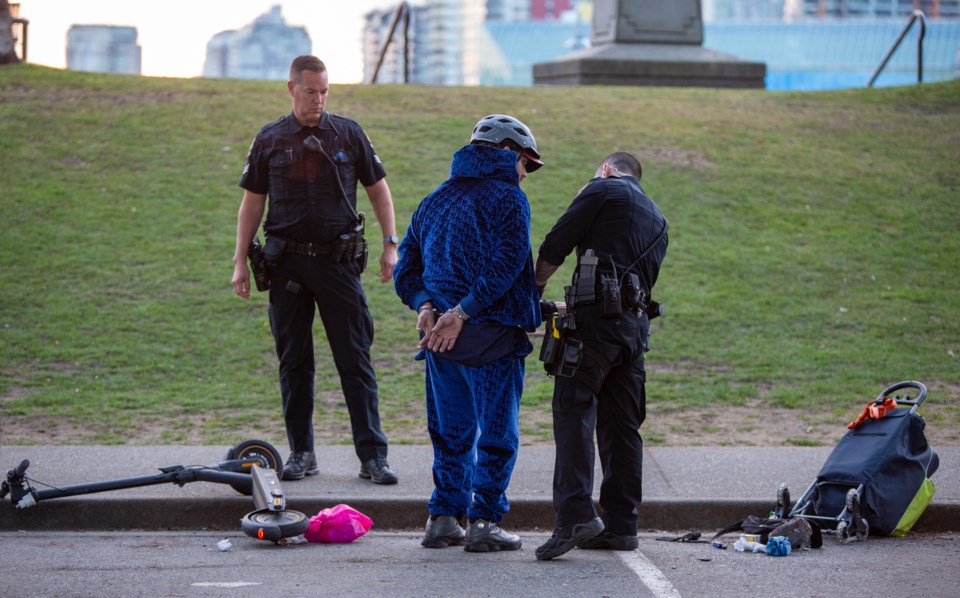A man is threatening to jump off the Lions Gate Bridge.
A man near the train station at Main Street and National Avenue has been robbed at knifepoint of his electric scooter.
Police are on alert for protesters outside a west side restaurant where a diplomat from India is dining.
These are some of the calls Vancouver police officers were dealing with Wednesday night as Insp. Marco Veronesi rolled through the city in his Ford Explorer, his laptop lit up with maps, statistics and details on each file.
The calls came in when Veronesi — the department’s duty officer for the night — was a few hours into his 12-hour shift, which began at 4:30 p.m.
By shift change in the morning, the call load will have topped 251.
Some will be serious (a woman in her 60s stabbed in the back several times in the Downtown Eastside), some not (providing a blanket for a young homeless man on Granville Street).
None of the calls will make the six o’clock news.
“A lot of us joined policing to go to those emergency calls, where the adrenalin gets going and you’re flying across the city to go do this or go do that — save a life, that kind of thing — but that's probably 10 to 20 per cent of the job,” said Veronesi, whose laptop screen was dominated at the time by calls for suicidal and missing persons.
Others in the queue included a parent worried about her son being bullied at school, a possible break-and-enter, a suspicious person report, a car accident, an alarm call to a restaurant, a check on the well-being of a person and a request for police to provide assistance to firefighters and paramedics.
The majority of calls was generated from the north side of the city.
Pandemic proved to be crime fighter
It’s now been three years this month since the pandemic forced a shutdown of businesses and workplaces, which in turn emptied the streets of people. The result was burglaries to homes, break-ins to cars and thefts plummeted.
At the same time, violent crime increased and anti-Asian hate crimes skyrocketed.
Police predict property crime will gradually return to pre-pandemic levels.
In the meantime, the number of calls related to a person experiencing a mental health crisis remain steady and continue to be a concern for police, a point Veronesi expanded on as he drove through the Olympic Village.
“It’s definitely worse since the pandemic,” he said. “People's mental health does not seem to be as good as it was before.”
Police released data in July 2022 that showed assaults committed by people not known to the victim found that mental health was a contributing factor in 73 per cent of 44 cases examined by the department.
Of 44 “stranger assaults,” 53 per cent involved a suspect who was previously apprehended by police under the Mental Health Act; total apprehensions under the act in 2022 reached 4,468.
Add a poisoned drug supply, a homelessness crisis, prohibitively expensive housing and food costs — all of it creating a widening gap between rich and poor — and policing the streets of Vancouver has become a challenging environment for officers.
They’re being spit on, punched and kicked more than ever, too, according to the department’s statistics. At the same time, questions around police-involved shootings and incidents where citizens have been injured or killed continue to make headlines.
Calls to de-fund the police persist.
So do the torqued-up love-hate takes about police via social media.
If there is any middle ground to the polarizing debate, it remains largely a silent public position, although the new city council led by Mayor Ken Sim and ABC Vancouver have committed to hire 100 police officers and 100 mental health workers while also backing a body-worn camera program.
It is with this backdrop that patrol officers under Veronesi’s command set out Wednesday across all four policing districts to arrest people, help people, search for people and thwart at least two potentially dangerous acts of violence involving weapons.
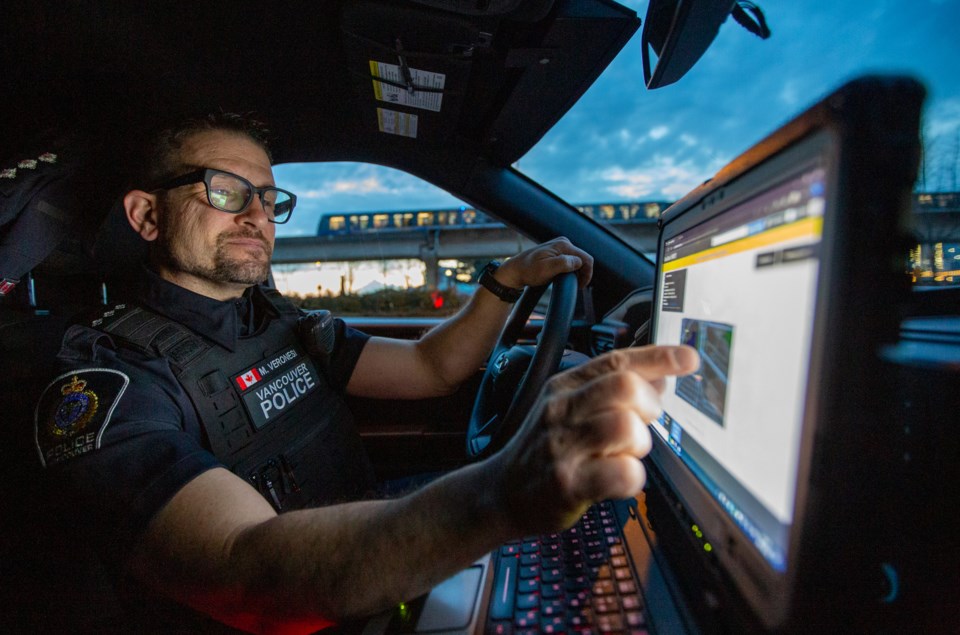
'Make sure no one's followed him'
From the seat of his SUV, Veronesi has everything at his fingertips that he needs to do his job.
As chief supervisor for officers on the road, he’s monitoring radios, taking phone calls from sergeants and dispatchers and keeping watch on the call load to see if one district is being overloaded and could use some help.
The operations command centre at the Cambie Street precinct is also a resource for him.
He takes a call from a sergeant working on the west side, where there is a concern that protests in India connected to Sikh separatist leader Amritpal Singh and internet restrictions will attract a crowd outside a restaurant where a diplomat from India is having dinner.
Veronesi: “How was the little protest that was supposed to happen?”
Sergeant: “It’s a non-event. The high council has just arrived on West Seventh and just gone inside. There's zero activity.”
Veronesi: “Based on what you’re seeing there, what do you think?”
Sergeant: “If I was a betting man, I’d say we’re good. We can stick around for a little while longer…to make sure no one's followed him from one of his previous locations. But there's been no activity all day today.”
The RCMP is also on hand and the sergeant says he will consult with them and later report back to Veronesi, who is satisfied with the plan.
Broken femur
As Veronesi finishes up the phone conversation, a call comes over the radio of a car accident involving a 62-year-old man on Franklin Street. It appears the man somehow ran himself over while getting in his car.
A police officer is heard updating the call and says the man has a broken femur.
“That’s not good,” Veronesi says.
At just after 6 p.m., the operations dashboard on Veronesi’s laptop shows 24 patrol units available and 22 others responding to calls.
Another 86 non-patrol units, which could be emergency response teams, drug squads or traffic units, are also signed on.
Veronesi can pull up a map to see where officers are located across the city, obtain fresh crime statistics for a neighbourhood, overlay data such as homes of known gangsters and compare call loads to previous months and years.
“So if you're a new cop, and you haven't really worked the city that much, or you're working in a different district, and you're starting to drive through it, this will alert you to there’s been say 10 crimes in the last five days in this area,” he says of another feature on his screen.
“You can pull them up and go, ‘Oh, looks like there's a bad [break-and-enter] person right around here, during these times and hours, and maybe I should pay attention.’”
An officer can also click on a map of the city to determine when a patrol car last toured a neighbourhood. The area will change colours on screen when it is time to send a unit for another visit.
“We now have an immense amount of information at our fingertips, which makes us way more efficient and effective,” says Veronesi, who joined the department in 1991 and recalls his car being equipped with a small computer screen with minimal capabilities and having to write reports by hand.
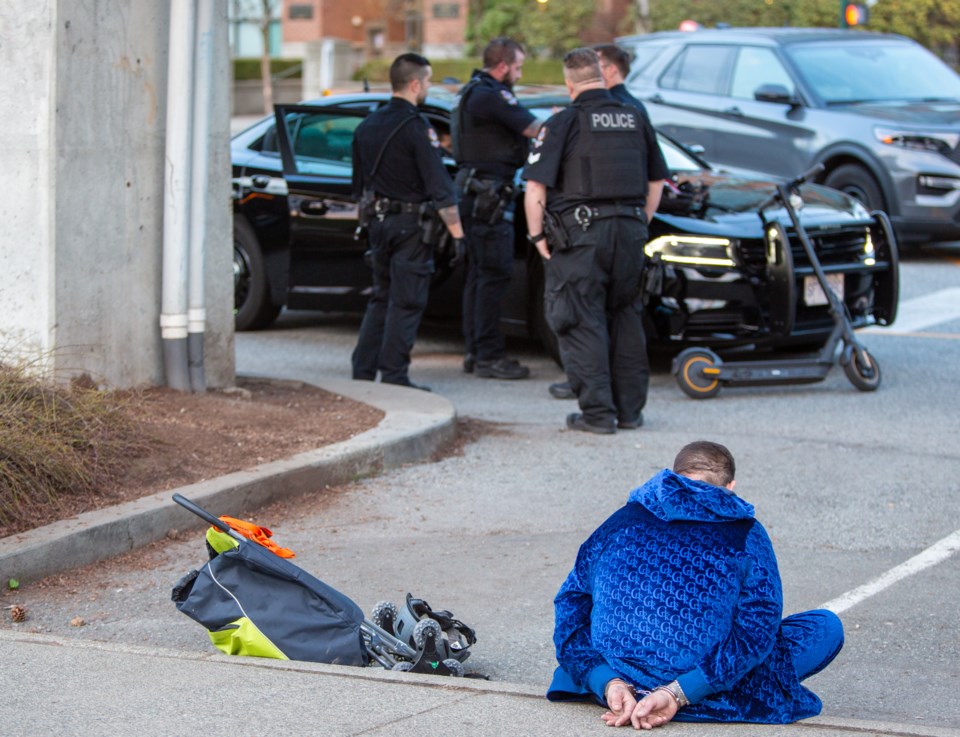
Shots fired at police, paramedics
Veronesi turns off Columbia Street on to the city’s most desolate strip — East Hastings, which tonight is no different than it has been since the pandemic, with tents lining the sidewalks, people in various states of being and at least one unconscious man being attended to by firefighters.
The man has overdosed outside the Carnegie Centre.
Veronesi exits his SUV and stands with other officers on the sidewalk to ensure firefighters and the arriving paramedics can do their job without any interference from people on the street.
Safety for emergency personnel on the strip is a genuine concern, says Veronesi, who went on to tell a story about paramedics and officers being shot at with a BB gun in January. The shooting occurred just steps away from where Veronesi is standing.
The shots came from the third floor of the Maple Hotel, across the street from the alley where paramedics had rolled up to a call. After being hit with pellets, paramedics called police, who were then shot at upon their arrival.
“You’ve got to have your head on an absolute swivel down here,” he says, looking up and down the strip at the chaotic scene of human misery.
Back in his vehicle, a call comes in for a man being robbed at knifepoint of his electric scooter. It’s nearby at Main and National, and apparently the victim is giving chase while providing a dispatcher with a description of the thief.
Within minutes, police locate a man in a blue tracksuit and arrest him in the Science World parking lot. The victim shows up at the scene, provides a statement for police and thanks them for returning his $1,200 scooter to him.
“So this guy will get charged with theft,” says Veronesi as officers load the man into a police wagon. “Unfortunately, nothing will happen [in terms of serious penalty], but at least this guy's happy because he gets his scooter back.”
The Downtown Eastside will prove to be the hotspot for calls as Veronesi’s shift continues throughout the evening and into the morning, which is not unusual. As he was coming on shift, a woman in her 60s was stabbed in the back several times.
The update from hospital was that she was in stable condition, but she refused to cooperate with police. Officers were still looking for two suspects.
“We'll take the report, we'll investigate it, we'll try to determine who did it because we don't want to have people going on stabbing sprees in the Downtown Eastside,” he says, noting stabbings and weapon calls are common in the neighbourhood.
'He looks pretty angry'
As the sun goes down, a call comes over the radio for a man with “a large hunter’s knife” walking in the 700-block of Main Street.
“He looks pretty angry, and he’s showing it at random people,” the dispatcher says.
Both uniformed and plainclothes officers begin to mobilize and ensure there is a beanbag shotgun available, as well as a Taser. They track the suspect to a convenience store at Main and Terminal.
Veronesi listens intently to the chatter on the radio.
“Our guys are doing all the right things here — they're building resources, making sure less lethal [options than a gun] are there in the event that this guy does present a knife and we end up having to deal with him,” he says.
“I’ll get involved if the sergeant is making bad calls that I don't like. Then I'll get on the radio and go, ‘No we're going to do this.’ But that’s not the case here.”
Officers note the concerns about pedestrians outside the store and have set up what Veronesi described as an “action line,” which is essentially a line of defence by police to prevent a suspect from harming others.
In the end, the man doesn’t put up a fight and police arrest him without incident.
The call could have easily gone the other way and resulted in the man being shot, which would have certainly made the news and triggered an investigation by the Independent Investigations Office.
“Those types of calls happen quite often, but [the public doesn’t] hear about them,” says Veronesi, as he scrolled through more calls on his laptop screen.
Calls regarding a suicidal person are also not newsmakers, but they require an emergency response that can involve several officers and mean shutting down bridges and transit service.
At just after 8 p.m., a call comes in from a person saying her friend’s ex-boyfriend plans to jump off the Lions Gate Bridge. Police mobilize and begin to search for the man, whose cellphone is “pinged” by the dispatcher to help with location.
Seven units from Vancouver are on the call, including an officer dispatched to the caller’s location. Officers from West Vancouver and North Vancouver have also joined the search for the man.
“So when you look at how many officers are involved, it’s what a lot of small departments would have for their whole night,” says Veronesi, parked on a side street in the downtown business district. “And we're able to throw those resources at this in order to try to find the guy.”
And they do eventually find him — on the bridge, where police arrange to take him to hospital.
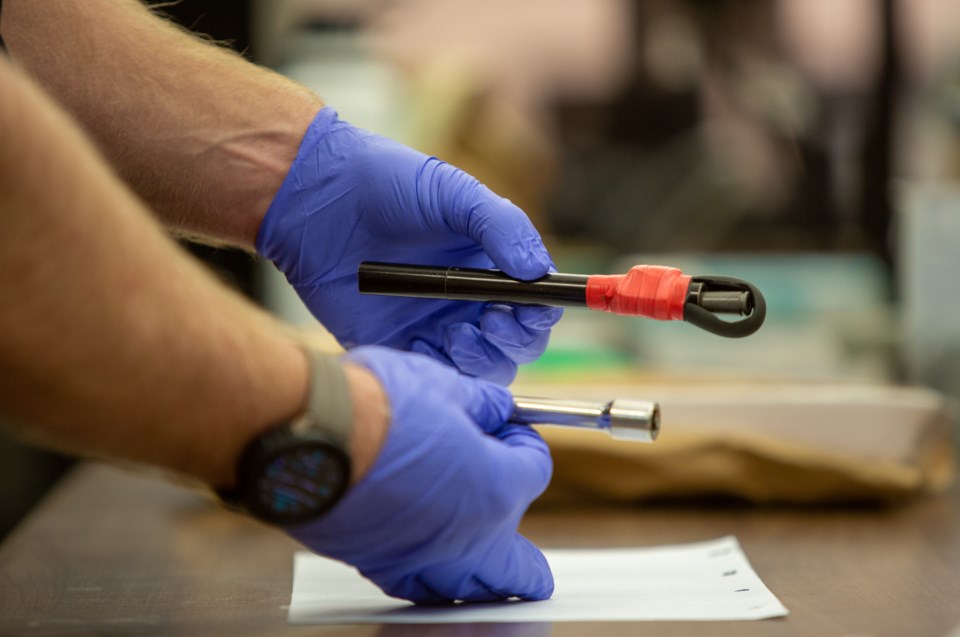
Drugs, meat and 'zip gun'
As Veronesi is listening in on the suicide call, his cellphone rings.
It’s a sergeant seeking advice on next steps in a sexual assault investigation.
A woman has just told one of the sergeant’s squad members that she was assaulted about three weeks ago, which is not an uncommon time period for a person to come forward with details of an incident; statistics show 19.6 per cent of sexual offences reported to the VPD in 2022 were historical and occurred in previous years.
Veronesi provides the officer with the on-call number for an expert to respond to questions.
Throughout the shift, he is constantly getting updated from officers and dispatchers about incidents. In some cases, he will attend the scene and in others he will be on the phone or radio to resolve any issues or get details on a file.
During a stop at the department’s satellite office on East Cordova Street, he talks to constables Adam Hohmann and Boyd Richardson about an arrest they made at Carrall and East Hastings.
A man was jaywalking in front of their cruiser and carrying a bag with a $55 package of ribeye steaks from the Grandview Highway Superstore.
The officers stopped him and found that he was in possession of fentanyl, crystal methamphetamine or crack cocaine, a quantity above the legal limit under the province’s new decriminalization laws.
Most concerning to Hohmann and Richardson was that the man was concealing a “zip gun,” a crude but effective pipe-like device that can fire a bullet, which was lodged in the firearm.
The man, who is from Manitoba and has warrants for his arrest, volunteered to the officers that he was an enforcer for a gang.
“This group in particular that he's talking about have a massive presence down here right now, and they openly wear colours,” Hohmann said. “Recently, they've been down here claiming to be community advocates and doing charity work and so on and so forth.”
Richardson said the man will likely be released in the morning with a future court date.
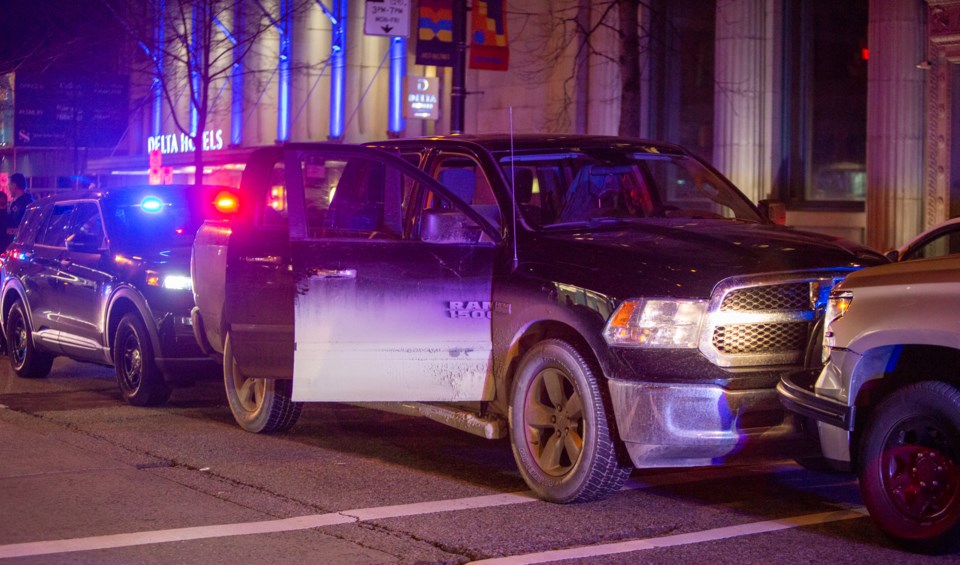
Stolen licence plates
Back on the street, five men in a Dodge pickup truck are driving along West Hastings in front of Harbour Centre when suddenly they are pinned in by police vehicles at the intersection.
They are told to come out with their hands in the air.
The scene, along with a large presence of police, stops pedestrians in their tracks.
The truck’s occupants comply with orders and are visibly confused by the interaction.
Turns out the driver of the truck, who is from Vancouver Island, reported his licence plates stolen to Nanaimo RCMP some time ago. He later recovered his plates but didn’t update RCMP, leaving VPD officers to assume the truck was stolen.
Officers apologized to the men, who said they were in town for an elders’ meeting. An officer ends up transporting them to their hotel.
As Veronesi is making the rounds in another part of the city, he gets a follow-up call from a sergeant who was at the truck incident.
Veronesi: “Were they happy with the police response, or how did that go?”
Sergeant: “They were relatively OK, despite their bumper getting pushed in a little bit. But all five gentlemen have been given contact information and a file number, and they all seem pretty positive about the experience, despite the circumstances.”
A few blocks away, on the Granville Street strip, police get called to a report of an “unwanted person,” which turns out to be a young homeless man named Evan.
He tells police he was trying fix a metal gate outside the Hotel Belmont.
Or was he trying to bend the gate enough to get behind it and have a safe place to sleep for the night?
Police aren’t sure but they learn the man is from White Rock and has family in Langley. He hasn’t had a job for more than a year, he says, and will be sleeping somewhere on Granville Street tonight.
Officers ask him to move along and promise to get him a blanket before their shift ends.
'That's rewarding too'
As midnight comes and goes, the calls keep coming — a female is choking a man by a downtown SkyTrain station, a suspicious man is trying the door of a person’s home near Montcalm and Southeast Marine Drive, a man just had his bike taken by another man on West Eighth Avenue, a man is carrying an imitation gun in the Downtown Eastside.
Calls regarding suicidal persons and missing persons remain constant.
Veronesi’s shift will end in three hours before he returns later in the day to start all over again.
Is there such thing as a good night in policing?
“When it’s crazy busy and you’re going from gun call to knife call, where you’re exercising your policing abilities and resolving incidents successfully — that’s a good night for me,” he says, his SUV idling in an alley in Mount Pleasant.
“There's also other times where a kid is missing, and you find that kid and reunite him with his mother. That’s rewarding, too.”
It is not a job, however, for everyone.
“But for those that it is for, it's awesome.”
